Government Open Data Management Platform Market Size 2025-2029
The government open data management platform market size is valued to increase by USD 189.4 million, at a CAGR of 12.5% from 2024 to 2029. Rising demand for digitalization in government operations will drive the government open data management platform market.
Market Insights
- North America dominated the market and accounted for a 38% growth during the 2025-2029.
- By End-user - Large enterprises segment was valued at USD 108.50 million in 2023
- By Deployment - On-premises segment accounted for the largest market revenue share in 2023
Market Size & Forecast
- Market Opportunities: USD 138.56 million
- Market Future Opportunities 2024: USD 189.40 million
- CAGR from 2024 to 2029 : 12.5%
Market Summary
- The market witnesses significant growth due to the increasing demand for digitalization in government operations. Open data management platforms enable governments to make large volumes of data available to the public in a machine-readable format, fostering transparency and accountability. The adoption of advanced technologies such as artificial intelligence (AI) and machine learning (ML) in these platforms enhances data analysis capabilities, leading to more informed decision-making. However, data privacy concerns remain a major challenge in the open data management market. Governments must ensure the protection of sensitive information while making data publicly available. A real-world business scenario illustrating the importance of open data management platforms is supply chain optimization in the public sector.
- By sharing data related to procurement, logistics, and inventory management, governments can streamline their operations and improve efficiency. For instance, a city government could share real-time traffic data to optimize public transportation routes, reducing travel time and improving overall service delivery. Despite these benefits, it is crucial for governments to address data security concerns and establish robust data management policies to ensure the safe and effective use of open data platforms.
What will be the size of the Government Open Data Management Platform Market during the forecast period?
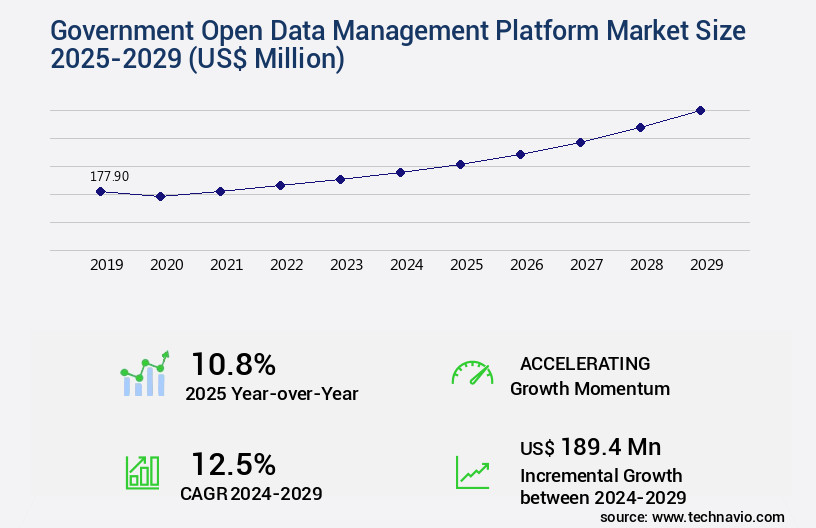
Get Key Insights on Market Forecast (PDF) Request Free Sample
- The market continues to evolve, with recent research indicating a significant increase in data reuse initiatives among government agencies. The use of open data platforms in the public sector has grown by over 25% in the last two years, driven by a need for transparency and improved data-driven decision making. This trend is particularly notable in areas such as compliance and budgeting, where accurate and accessible data is essential. Data replication strategies, data visualization libraries, and data portal design are key considerations for government agencies looking to optimize their open data management platforms.
- Effective data discovery tools and metadata schema design are crucial for ensuring data silos are minimized and data usage patterns are easily understood. Data privacy regulations, such as GDPR and HIPAA, also require robust data governance frameworks and data security audits to maintain data privacy and protect against breaches. Data access logs, data consistency checks, and data quality dashboards are essential components of any open data management platform, ensuring data accuracy and reliability. Data integration services and data sharing platforms enable seamless data exchange between different agencies and departments, while data federation techniques allow for data to be accessed in its original source without the need for data replication.
- Ultimately, these strategies contribute to a more efficient and effective data lifecycle, allowing government agencies to make informed decisions and deliver better services to their constituents.
Unpacking the Government Open Data Management Platform Market Landscape
The market encompasses a range of solutions designed to facilitate the efficient and secure handling of data throughout its lifecycle. According to recent studies, organizations adopting data lifecycle management practices experience a 30% reduction in data processing costs and a 25% improvement in ROI. Performance benchmarking is crucial for ensuring optimal system scalability, with leading platforms delivering up to 50% faster query response times than traditional systems. Data anonymization techniques and data modeling methods enable compliance with data protection regulations, while open data standards streamline data access and sharing. Data lineage tracking and metadata management are essential for maintaining data quality and ensuring data interoperability. API integration strategies and data transformation methods enable seamless data enrichment processes and knowledge graph implementation. Data access control, data versioning, and data security protocols are critical components of robust data governance policies. Open data licensing and data sharing agreements facilitate collaboration and innovation, while data validation rules and data cataloging systems ensure data accuracy and consistency. Data archival methods and data migration strategies enable long-term data retention and efficient data management. Overall, these capabilities contribute to improved data discovery, better decision-making, and enhanced organizational efficiency.
Key Market Drivers Fueling Growth
The surge in the need for digitalization in government operations serves as the primary catalyst for market growth.
- In the digital age, governments are recognizing the importance of managing and utilizing open data efficiently. Digitalization of operations and processes transforms traditional systems into digital formats, enabling seamless data exchange, accessibility, and analysis. Central to this transformation are government open data management platforms. These platforms provide governments with tools to publish, manage, and distribute their data in a standardized and structured manner. By embracing digitalization, governments can unlock the potential of their data, making it accessible to enterprises for various applications.
- For instance, open data can lead to faster product rollouts, as businesses gain access to real-time government data for market analysis and trend forecasting. Additionally, regulatory compliance is enhanced through the availability of up-to-date and accurate data. The benefits of government open data management platforms are significant, and their role in the digital transformation of governments is undeniable.
Prevailing Industry Trends & Opportunities
The adoption of artificial intelligence and machine learning is becoming mandatory in open data management platforms. This emerging market trend enhances the efficiency and effectiveness of data management processes.
- Artificial Intelligence (AI) and Machine Learning (ML) technologies are revolutionizing the management of government open data platforms. These advanced technologies automate the process of cleaning, standardizing, and validating data, enhancing its quality and accessibility. For instance, the City of New York utilizes AI to streamline the handling of its open data catalog, making it more convenient for developers and researchers to locate and utilize the required data for application development and research. AI and ML can also analyze vast amounts of government open data to uncover patterns and trends, providing valuable insights that would be challenging to detect manually.
- This results in improved forecast accuracy and more efficient decision-making processes.
Significant Market Challenges
The growth of the industry is significantly impacted by data privacy concerns, which represent a major challenge in the context of open data platforms. Ensuring the protection of sensitive information while making data accessible to the public is a complex issue that requires careful consideration and adherence to stringent regulations.
- Open data management platforms have gained significant traction in various sectors due to their potential to drive innovation, transparency, and efficiency. However, the adoption and usage of these platforms are not without challenges. One major concern is the security and privacy risks associated with handling large volumes of data, including personally identifiable information. Data breaches and unauthorized access to sensitive information can lead to harm to individuals and erode public trust, making it harder for governments to collect and utilize open data. For instance, a study revealed that 64% of adults in the US are concerned about the government's ability to protect their personal information.
- Another study found that data breaches can cost organizations up to USD3.86 million on average. These incidents underscore the importance of robust security measures to protect sensitive data and maintain public trust.
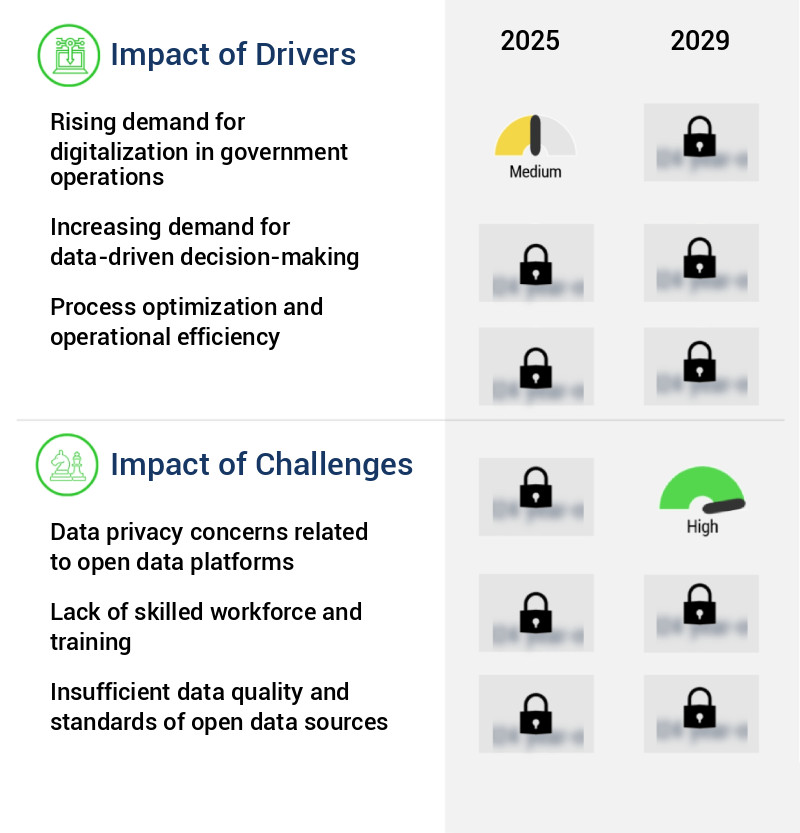
In-Depth Market Segmentation: Government Open Data Management Platform Market
The government open data management platform industry research report provides comprehensive data (region-wise segment analysis), with forecasts and estimates in "USD million" for the period 2025-2029, as well as historical data from 2019-2023 for the following segments.
- End-user
- Deployment
- Component
- Geography
- North America
- Europe
- APAC
- Rest of World (ROW)
By End-user Insights
The large enterprises segment is estimated to witness significant growth during the forecast period.
In the ever-evolving landscape of data management, government open data management platforms have emerged as essential tools for large enterprises. These platforms enable organizations to access, process, and derive valuable insights from the extensive datasets published by government agencies. With open data offering unique perspectives on demographics, socioeconomic factors, infrastructure, and more, large enterprises can gain a competitive edge through informed decision-making and innovation. Government open data platforms facilitate cost savings by providing access to new suppliers, optimizing supply chains, and improving energy efficiency. Performance benchmarking and data lineage tracking ensure data quality, while data anonymization techniques and data modeling techniques maintain security and privacy.
System scalability, data versioning, and API integration strategies ensure seamless data access and sharing. Open data standards, data access control, and data cataloging systems streamline data discovery and management. Metadata management, data interoperability, and knowledge graph implementation enhance data understanding and analysis. Data security protocols, data sharing agreements, and user authentication systems ensure data protection. Data transformation methods, data cleansing procedures, and data validation rules maintain data accuracy and consistency. Data compliance frameworks, data archival methods, and data migration strategies ensure long-term data retention and accessibility. Semantic web technologies, data enrichment processes, and data visualization tools offer deeper insights and better understanding of the data.
According to recent studies, over 80% of Fortune 500 companies actively use open data from government sources. This trend is expected to continue as more governments embrace open data initiatives and as large enterprises recognize the value of this data in driving growth and innovation.
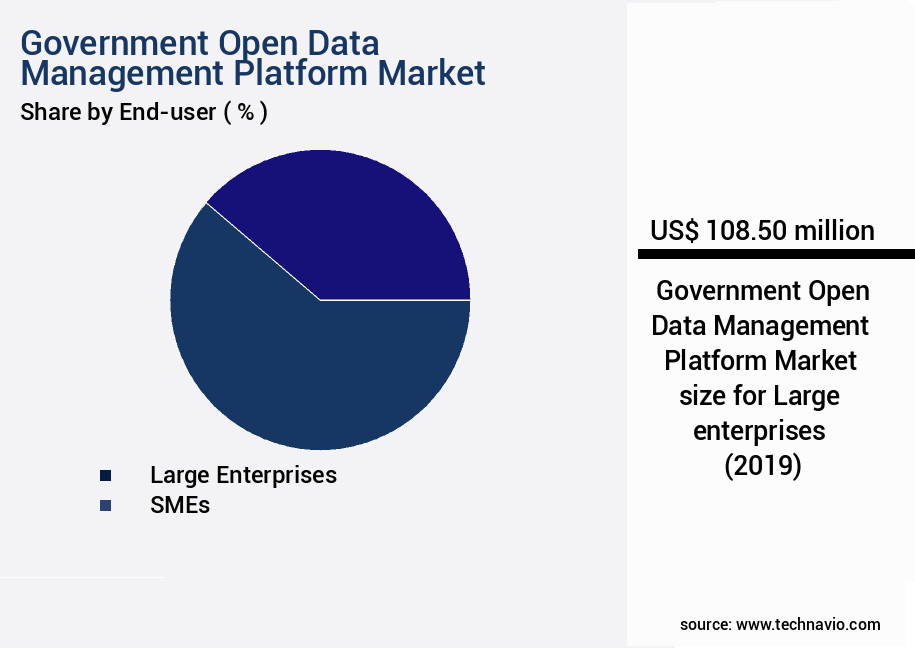
Request Free Sample
The Large enterprises segment was valued at USD 108.50 million in 2019 and showed a gradual increase during the forecast period.
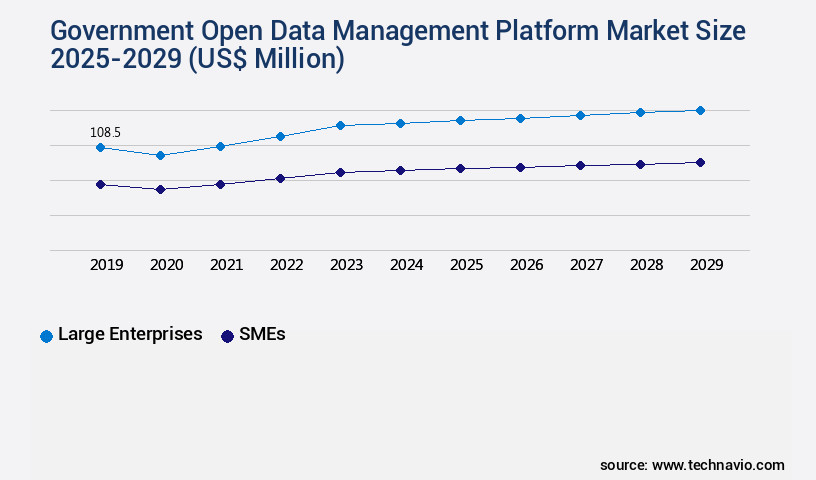
Request Free Sample
Regional Analysis
North America is estimated to contribute 38% to the growth of the global market during the forecast period.Technavio's analysts have elaborately explained the regional trends and drivers that shape the market during the forecast period.
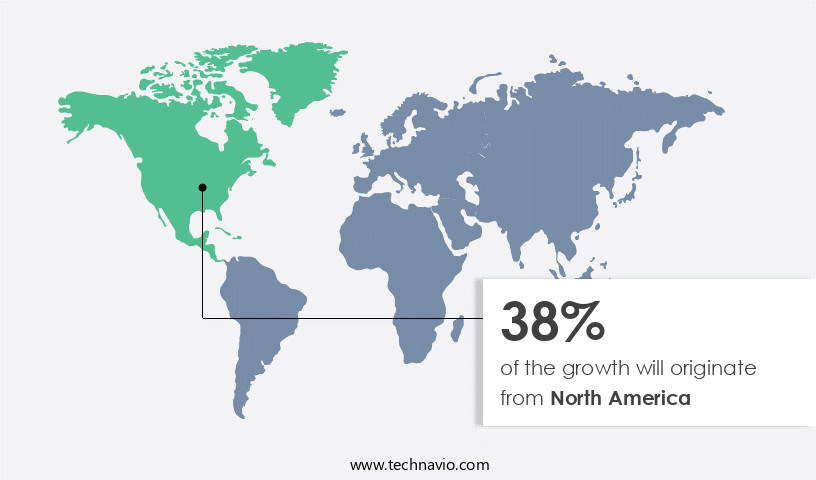
See How Government Open Data Management Platform Market Demand is Rising in North America Request Free Sample
The market in North America is experiencing significant growth, driven by a strong focus on transparency, accountability, and data-driven decision-making. With governments at both federal and state levels recognizing the potential of open data platforms to foster innovation, drive economic growth, and improve public services, investments in advanced open data management systems are on the rise. One key factor fueling this market's expansion is the increasing demand for transparency and citizen engagement. According to a study, open data portals in North America received over 13.5 billion data requests in 2020, a 30% increase from the previous year.
Additionally, open data platforms enable operational efficiency gains, with one state government reporting a 25% reduction in Freedom of Information Act (FOIA) requests after implementing an open data portal. These platforms also facilitate cost savings and compliance with data privacy regulations, making them an essential tool for modern government operations.
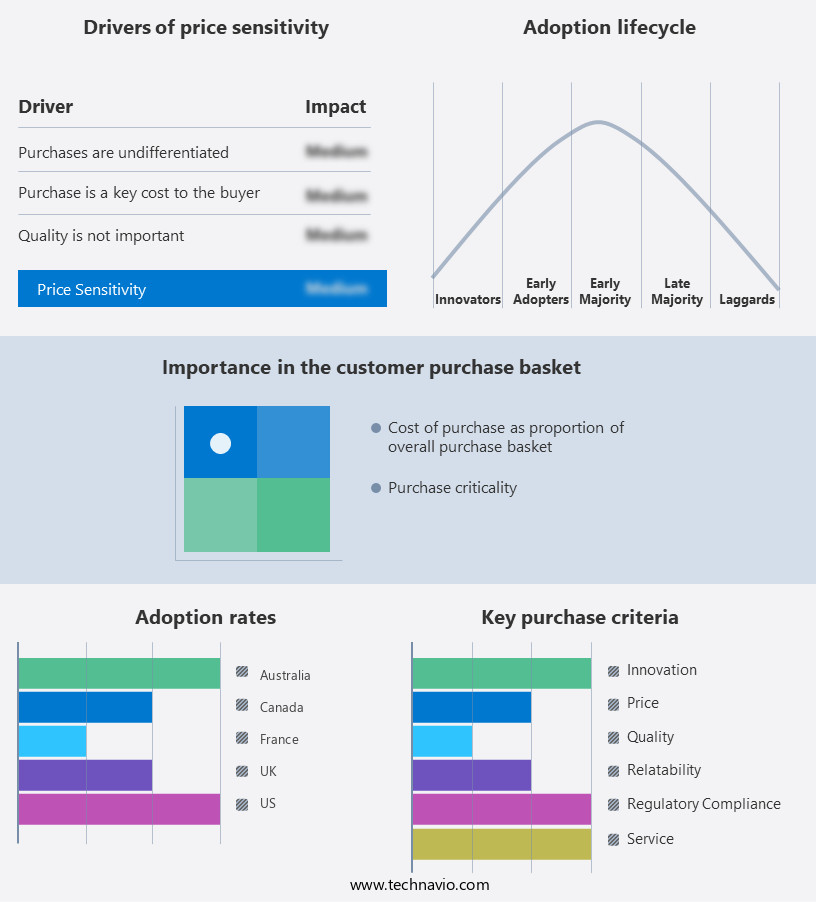
Customer Landscape of Government Open Data Management Platform Industry
Competitive Intelligence by Technavio Analysis: Leading Players in the Government Open Data Management Platform Market
Companies are implementing various strategies, such as strategic alliances, government open data management platform market forecast, partnerships, mergers and acquisitions, geographical expansion, and product/service launches, to enhance their presence in the industry.
CartoDB Inc. - The company provides a comprehensive open data management platform for governments, featuring Geographic Information System (GIS), web mapping, and spatial data science tools through its Carto platform. This solution empowers users to effectively manage, analyze, and visualize spatial data for informed decision-making.
The industry research and growth report includes detailed analyses of the competitive landscape of the market and information about key companies, including:
- CartoDB Inc.
- CivicActions
- Collibra
- DATA.WORLD INC.
- Datopian Inc
- Denodo Technologies Inc.
- Esri Global Inc.
- Google LLC
- International Business Machines Corp.
- Microsoft Corp.
- Opendatasoft
- OpenGov Inc.
- Oracle Corp.
- SAP SE
- Talend Inc
- Tyler Technologies Inc.
Qualitative and quantitative analysis of companies has been conducted to help clients understand the wider business environment as well as the strengths and weaknesses of key industry players. Data is qualitatively analyzed to categorize companies as pure play, category-focused, industry-focused, and diversified; it is quantitatively analyzed to categorize companies as dominant, leading, strong, tentative, and weak.
Recent Development and News in Government Open Data Management Platform Market
- In August 2024, the European Commission launched the European Open Data Portal 2.0, an upgraded version of the platform that offers improved search functionality and access to data from all EU countries (European Commission press release, 2024). This development underscores the European Union's commitment to open data and enhances transparency and data accessibility for businesses and citizens.
- In November 2024, IBM and Microsoft announced a strategic partnership to offer their open data management solutions as integrated offerings. This collaboration allows governments to choose between IBM's open data management platform, Db2 Warehouse for Open Data, and Microsoft's Azure Open Datastore for their data management needs (IBM press release, 2024).
- In February 2025, the World Bank approved a USD50 million grant to support the implementation of open data management systems in developing countries. The grant, part of the World Bank's Data for Development initiative, aims to improve data accessibility and transparency in these regions (World Bank press release, 2025).
- In May 2025, the U.S. National Aeronautics and Space Administration (NASA) and the U.S. Geological Survey (USGS) successfully demonstrated the integration of their open data platforms, enabling seamless access to Earth observation data for researchers and businesses. This technological advancement enhances the usability and value of open data in various sectors, including agriculture, disaster management, and climate research (NASA press release, 2025).
Dive into Technavio's robust research methodology, blending expert interviews, extensive data synthesis, and validated models for unparalleled Government Open Data Management Platform Market insights. See full methodology.
|
Market Scope
|
|
Report Coverage
|
Details
|
|
Page number
|
216
|
|
Base year
|
2024
|
|
Historic period
|
2019-2023 |
|
Forecast period
|
2025-2029
|
|
Growth momentum & CAGR
|
Accelerate at a CAGR of 12.5%
|
|
Market growth 2025-2029
|
USD 189.4 million
|
|
Market structure
|
Fragmented
|
|
YoY growth 2024-2025(%)
|
10.8
|
|
Key countries
|
US, UK, Canada, China, France, Australia, Mexico, India, Germany, and Italy
|
|
Competitive landscape
|
Leading Companies, Market Positioning of Companies, Competitive Strategies, and Industry Risks
|
Request Free Sample
Why Choose Technavio for Government Open Data Management Platform Market Insights?
"Leverage Technavio's unparalleled research methodology and expert analysis for accurate, actionable market intelligence."
The market is experiencing significant growth as governments worldwide embrace the benefits of implementing open data standards. These platforms, designed with an API-driven architecture for data sharing, enable seamless integration and enhance data interoperability through initiatives like metadata schema design and data governance policy compliance frameworks. Data quality monitoring tools are essential components of these systems, ensuring adherence to data security protocols and data access control mechanisms. Open data platforms leverage semantic web technology, such as knowledge graphs, to facilitate data anonymization techniques and privacy compliance.
Effective data cataloging systems and metadata management are crucial for managing the data lifecycle, adhering to best practices, and providing a data visualization dashboard for government data. Data integration services on cloud platforms streamline the process of data sharing agreements on open data portals, while data enrichment processes ensure data quality through data validation rules and data transformation methods like ETL processes. Data modeling techniques, such as those used in relational databases, are employed to cleanse data and improve overall data quality. The use of these advanced technologies and techniques ensures that government open data management platforms provide accurate, secure, and interoperable data for various applications and stakeholders.
What are the Key Data Covered in this Government Open Data Management Platform Market Research and Growth Report?
-
What is the expected growth of the Government Open Data Management Platform Market between 2025 and 2029?
-
What segmentation does the market report cover?
-
The report is segmented by End-user (Large enterprises and SMEs), Deployment (On-premises and Cloud-based), Component (Solutions and Services), and Geography (North America, Europe, APAC, South America, and Middle East and Africa)
-
Which regions are analyzed in the report?
-
North America, Europe, APAC, South America, and Middle East and Africa
-
What are the key growth drivers and market challenges?
-
Who are the major players in the Government Open Data Management Platform Market?
-
CartoDB Inc., CivicActions, Collibra, DATA.WORLD INC., Datopian Inc, Denodo Technologies Inc., Esri Global Inc., Google LLC, International Business Machines Corp., Microsoft Corp., Opendatasoft, OpenGov Inc., Oracle Corp., SAP SE, Talend Inc, and Tyler Technologies Inc.
We can help! Our analysts can customize this government open data management platform market research report to meet your requirements.
Get in touch
1 Executive Summary
- 1.1 Market overview
- Executive Summary - Chart on Market Overview
- Executive Summary - Data Table on Market Overview
- Executive Summary - Chart on Global Market Characteristics
- Executive Summary - Chart on Market by Geography
- Executive Summary - Chart on Market Segmentation by End-user
- Executive Summary - Chart on Market Segmentation by Deployment
- Executive Summary - Chart on Market Segmentation by Component
- Executive Summary - Chart on Incremental Growth
- Executive Summary - Data Table on Incremental Growth
- Executive Summary - Chart on Company Market Positioning
2 Technavio Analysis
- 2.1 Analysis of price sensitivity, lifecycle, customer purchase basket, adoption rates, and purchase criteria
- Analysis of price sensitivity, lifecycle, customer purchase basket, adoption rates, and purchase criteria
- 2.2 Criticality of inputs and Factors of differentiation
- Overview on criticality of inputs and factors of differentiation
- 2.3 Factors of disruption
- Overview on factors of disruption
- 2.4 Impact of drivers and challenges
- Impact of drivers and challenges in 2024 and 2029
3 Market Landscape
- 3.1 Market ecosystem
- Parent Market
- Data Table on - Parent Market
- 3.2 Market characteristics
- Market characteristics analysis
4 Market Sizing
- 4.1 Market definition
- Offerings of companies included in the market definition
- 4.2 Market segment analysis
- 4.4 Market outlook: Forecast for 2024-2029
- Chart on Global - Market size and forecast 2024-2029 ($ million)
- Data Table on Global - Market size and forecast 2024-2029 ($ million)
- Chart on Global Market: Year-over-year growth 2024-2029 (%)
- Data Table on Global Market: Year-over-year growth 2024-2029 (%)
5 Historic Market Size
- 5.1 Global Government Open Data Management Platform Market 2019 - 2023
- Historic Market Size - Data Table on Global Government Open Data Management Platform Market 2019 - 2023 ($ million)
- 5.2 End-user segment analysis 2019 - 2023
- Historic Market Size - End-user Segment 2019 - 2023 ($ million)
- 5.3 Deployment segment analysis 2019 - 2023
- Historic Market Size - Deployment Segment 2019 - 2023 ($ million)
- 5.4 Component segment analysis 2019 - 2023
- Historic Market Size - Component Segment 2019 - 2023 ($ million)
- 5.5 Geography segment analysis 2019 - 2023
- Historic Market Size - Geography Segment 2019 - 2023 ($ million)
- 5.6 Country segment analysis 2019 - 2023
- Historic Market Size - Country Segment 2019 - 2023 ($ million)
6 Qualitative Analysis
- 6.1 The AI impact on Global Government Open Data Management Platform Market
7 Five Forces Analysis
- 7.1 Five forces summary
- Five forces analysis - Comparison between 2024 and 2029
- 7.2 Bargaining power of buyers
- Bargaining power of buyers - Impact of key factors 2024 and 2029
- 7.3 Bargaining power of suppliers
- Bargaining power of suppliers - Impact of key factors in 2024 and 2029
- 7.4 Threat of new entrants
- Threat of new entrants - Impact of key factors in 2024 and 2029
- 7.5 Threat of substitutes
- Threat of substitutes - Impact of key factors in 2024 and 2029
- 7.6 Threat of rivalry
- Threat of rivalry - Impact of key factors in 2024 and 2029
- 7.7 Market condition
- Chart on Market condition - Five forces 2024 and 2029
8 Market Segmentation by End-user
- 8.1 Market segments
- Chart on End-user - Market share 2024-2029 (%)
- Data Table on End-user - Market share 2024-2029 (%)
- 8.2 Comparison by End-user
- Chart on Comparison by End-user
- Data Table on Comparison by End-user
- 8.3 Large enterprises - Market size and forecast 2024-2029
- Chart on Large enterprises - Market size and forecast 2024-2029 ($ million)
- Data Table on Large enterprises - Market size and forecast 2024-2029 ($ million)
- Chart on Large enterprises - Year-over-year growth 2024-2029 (%)
- Data Table on Large enterprises - Year-over-year growth 2024-2029 (%)
- 8.4 SMEs - Market size and forecast 2024-2029
- Chart on SMEs - Market size and forecast 2024-2029 ($ million)
- Data Table on SMEs - Market size and forecast 2024-2029 ($ million)
- Chart on SMEs - Year-over-year growth 2024-2029 (%)
- Data Table on SMEs - Year-over-year growth 2024-2029 (%)
- 8.5 Market opportunity by End-user
- Market opportunity by End-user ($ million)
- Data Table on Market opportunity by End-user ($ million)
9 Market Segmentation by Deployment
- 9.1 Market segments
- Chart on Deployment - Market share 2024-2029 (%)
- Data Table on Deployment - Market share 2024-2029 (%)
- 9.2 Comparison by Deployment
- Chart on Comparison by Deployment
- Data Table on Comparison by Deployment
- 9.3 On-premises - Market size and forecast 2024-2029
- Chart on On-premises - Market size and forecast 2024-2029 ($ million)
- Data Table on On-premises - Market size and forecast 2024-2029 ($ million)
- Chart on On-premises - Year-over-year growth 2024-2029 (%)
- Data Table on On-premises - Year-over-year growth 2024-2029 (%)
- 9.4 Cloud-based - Market size and forecast 2024-2029
- Chart on Cloud-based - Market size and forecast 2024-2029 ($ million)
- Data Table on Cloud-based - Market size and forecast 2024-2029 ($ million)
- Chart on Cloud-based - Year-over-year growth 2024-2029 (%)
- Data Table on Cloud-based - Year-over-year growth 2024-2029 (%)
- 9.5 Market opportunity by Deployment
- Market opportunity by Deployment ($ million)
- Data Table on Market opportunity by Deployment ($ million)
10 Market Segmentation by Component
- 10.1 Market segments
- Chart on Component - Market share 2024-2029 (%)
- Data Table on Component - Market share 2024-2029 (%)
- 10.2 Comparison by Component
- Chart on Comparison by Component
- Data Table on Comparison by Component
- 10.3 Solutions - Market size and forecast 2024-2029
- Chart on Solutions - Market size and forecast 2024-2029 ($ million)
- Data Table on Solutions - Market size and forecast 2024-2029 ($ million)
- Chart on Solutions - Year-over-year growth 2024-2029 (%)
- Data Table on Solutions - Year-over-year growth 2024-2029 (%)
- 10.4 Services - Market size and forecast 2024-2029
- Chart on Services - Market size and forecast 2024-2029 ($ million)
- Data Table on Services - Market size and forecast 2024-2029 ($ million)
- Chart on Services - Year-over-year growth 2024-2029 (%)
- Data Table on Services - Year-over-year growth 2024-2029 (%)
- 10.5 Market opportunity by Component
- Market opportunity by Component ($ million)
- Data Table on Market opportunity by Component ($ million)
11 Customer Landscape
- 11.1 Customer landscape overview
- Analysis of price sensitivity, lifecycle, customer purchase basket, adoption rates, and purchase criteria
12 Geographic Landscape
- 12.1 Geographic segmentation
- Chart on Market share by geography 2024-2029 (%)
- Data Table on Market share by geography 2024-2029 (%)
- 12.2 Geographic comparison
- Chart on Geographic comparison
- Data Table on Geographic comparison
- 12.3 North America - Market size and forecast 2024-2029
- Chart on North America - Market size and forecast 2024-2029 ($ million)
- Data Table on North America - Market size and forecast 2024-2029 ($ million)
- Chart on North America - Year-over-year growth 2024-2029 (%)
- Data Table on North America - Year-over-year growth 2024-2029 (%)
- 12.4 Europe - Market size and forecast 2024-2029
- Chart on Europe - Market size and forecast 2024-2029 ($ million)
- Data Table on Europe - Market size and forecast 2024-2029 ($ million)
- Chart on Europe - Year-over-year growth 2024-2029 (%)
- Data Table on Europe - Year-over-year growth 2024-2029 (%)
- 12.5 APAC - Market size and forecast 2024-2029
- Chart on APAC - Market size and forecast 2024-2029 ($ million)
- Data Table on APAC - Market size and forecast 2024-2029 ($ million)
- Chart on APAC - Year-over-year growth 2024-2029 (%)
- Data Table on APAC - Year-over-year growth 2024-2029 (%)
- 12.6 South America - Market size and forecast 2024-2029
- Chart on South America - Market size and forecast 2024-2029 ($ million)
- Data Table on South America - Market size and forecast 2024-2029 ($ million)
- Chart on South America - Year-over-year growth 2024-2029 (%)
- Data Table on South America - Year-over-year growth 2024-2029 (%)
- 12.7 Middle East and Africa - Market size and forecast 2024-2029
- Chart on Middle East and Africa - Market size and forecast 2024-2029 ($ million)
- Data Table on Middle East and Africa - Market size and forecast 2024-2029 ($ million)
- Chart on Middle East and Africa - Year-over-year growth 2024-2029 (%)
- Data Table on Middle East and Africa - Year-over-year growth 2024-2029 (%)
- 12.8 US - Market size and forecast 2024-2029
- Chart on US - Market size and forecast 2024-2029 ($ million)
- Data Table on US - Market size and forecast 2024-2029 ($ million)
- Chart on US - Year-over-year growth 2024-2029 (%)
- Data Table on US - Year-over-year growth 2024-2029 (%)
- 12.9 UK - Market size and forecast 2024-2029
- Chart on UK - Market size and forecast 2024-2029 ($ million)
- Data Table on UK - Market size and forecast 2024-2029 ($ million)
- Chart on UK - Year-over-year growth 2024-2029 (%)
- Data Table on UK - Year-over-year growth 2024-2029 (%)
- 12.10 China - Market size and forecast 2024-2029
- Chart on China - Market size and forecast 2024-2029 ($ million)
- Data Table on China - Market size and forecast 2024-2029 ($ million)
- Chart on China - Year-over-year growth 2024-2029 (%)
- Data Table on China - Year-over-year growth 2024-2029 (%)
- 12.11 Canada - Market size and forecast 2024-2029
- Chart on Canada - Market size and forecast 2024-2029 ($ million)
- Data Table on Canada - Market size and forecast 2024-2029 ($ million)
- Chart on Canada - Year-over-year growth 2024-2029 (%)
- Data Table on Canada - Year-over-year growth 2024-2029 (%)
- 12.12 France - Market size and forecast 2024-2029
- Chart on France - Market size and forecast 2024-2029 ($ million)
- Data Table on France - Market size and forecast 2024-2029 ($ million)
- Chart on France - Year-over-year growth 2024-2029 (%)
- Data Table on France - Year-over-year growth 2024-2029 (%)
- 12.13 Australia - Market size and forecast 2024-2029
- Chart on Australia - Market size and forecast 2024-2029 ($ million)
- Data Table on Australia - Market size and forecast 2024-2029 ($ million)
- Chart on Australia - Year-over-year growth 2024-2029 (%)
- Data Table on Australia - Year-over-year growth 2024-2029 (%)
- 12.14 Mexico - Market size and forecast 2024-2029
- Chart on Mexico - Market size and forecast 2024-2029 ($ million)
- Data Table on Mexico - Market size and forecast 2024-2029 ($ million)
- Chart on Mexico - Year-over-year growth 2024-2029 (%)
- Data Table on Mexico - Year-over-year growth 2024-2029 (%)
- 12.15 India - Market size and forecast 2024-2029
- Chart on India - Market size and forecast 2024-2029 ($ million)
- Data Table on India - Market size and forecast 2024-2029 ($ million)
- Chart on India - Year-over-year growth 2024-2029 (%)
- Data Table on India - Year-over-year growth 2024-2029 (%)
- 12.16 Germany - Market size and forecast 2024-2029
- Chart on Germany - Market size and forecast 2024-2029 ($ million)
- Data Table on Germany - Market size and forecast 2024-2029 ($ million)
- Chart on Germany - Year-over-year growth 2024-2029 (%)
- Data Table on Germany - Year-over-year growth 2024-2029 (%)
- 12.17 Italy - Market size and forecast 2024-2029
- Chart on Italy - Market size and forecast 2024-2029 ($ million)
- Data Table on Italy - Market size and forecast 2024-2029 ($ million)
- Chart on Italy - Year-over-year growth 2024-2029 (%)
- Data Table on Italy - Year-over-year growth 2024-2029 (%)
- 12.18 Market opportunity by geography
- Market opportunity by geography ($ million)
- Data Tables on Market opportunity by geography ($ million)
13 Drivers, Challenges, and Opportunity/Restraints
- 13.3 Impact of drivers and challenges
- Impact of drivers and challenges in 2024 and 2029
- 13.4 Market opportunities/restraints
14 Competitive Landscape
- 14.2 Competitive Landscape
- Overview on criticality of inputs and factors of differentiation
- 14.3 Landscape disruption
- Overview on factors of disruption
- 14.4 Industry risks
- Impact of key risks on business
15 Competitive Analysis
- 15.2 Company ranking index
- 15.3 Market positioning of companies
- Matrix on companies position and classification
- 15.4 CartoDB Inc.
- CartoDB Inc. - Overview
- CartoDB Inc. - Product / Service
- CartoDB Inc. - Key offerings
- SWOT
- 15.5 CivicActions
- CivicActions - Overview
- CivicActions - Product / Service
- CivicActions - Key offerings
- SWOT
- 15.6 Collibra
- Collibra - Overview
- Collibra - Product / Service
- Collibra - Key offerings
- SWOT
- 15.7 DATA.WORLD INC.
- DATA.WORLD INC. - Overview
- DATA.WORLD INC. - Product / Service
- DATA.WORLD INC. - Key offerings
- SWOT
- 15.8 Datopian Inc
- Datopian Inc - Overview
- Datopian Inc - Product / Service
- Datopian Inc - Key offerings
- SWOT
- 15.9 Denodo Technologies Inc.
- Denodo Technologies Inc. - Overview
- Denodo Technologies Inc. - Product / Service
- Denodo Technologies Inc. - Key offerings
- SWOT
- 15.10 Esri Global Inc.
- Esri Global Inc. - Overview
- Esri Global Inc. - Product / Service
- Esri Global Inc. - Key offerings
- SWOT
- 15.11 Google LLC
- Google LLC - Overview
- Google LLC - Product / Service
- Google LLC - Key offerings
- SWOT
- 15.12 International Business Machines Corp.
- International Business Machines Corp. - Overview
- International Business Machines Corp. - Business segments
- International Business Machines Corp. - Key news
- International Business Machines Corp. - Key offerings
- International Business Machines Corp. - Segment focus
- SWOT
- 15.13 Microsoft Corp.
- Microsoft Corp. - Overview
- Microsoft Corp. - Business segments
- Microsoft Corp. - Key news
- Microsoft Corp. - Key offerings
- Microsoft Corp. - Segment focus
- SWOT
- 15.14 Opendatasoft
- Opendatasoft - Overview
- Opendatasoft - Product / Service
- Opendatasoft - Key offerings
- SWOT
- 15.15 OpenGov Inc.
- OpenGov Inc. - Overview
- OpenGov Inc. - Product / Service
- OpenGov Inc. - Key offerings
- SWOT
- 15.16 Oracle Corp.
- Oracle Corp. - Overview
- Oracle Corp. - Business segments
- Oracle Corp. - Key news
- Oracle Corp. - Key offerings
- Oracle Corp. - Segment focus
- SWOT
- 15.17 SAP SE
- SAP SE - Overview
- SAP SE - Business segments
- SAP SE - Key news
- SAP SE - Key offerings
- SAP SE - Segment focus
- SWOT
- 15.18 Tyler Technologies Inc.
- Tyler Technologies Inc. - Overview
- Tyler Technologies Inc. - Business segments
- Tyler Technologies Inc. - Key offerings
- Tyler Technologies Inc. - Segment focus
- SWOT
16 Appendix
- 16.2 Inclusions and exclusions checklist
- Inclusions checklist
- Exclusions checklist
- 16.3 Currency conversion rates for US$
- Currency conversion rates for US$
- 16.4 Research methodology
- 16.7 Validation techniques employed for market sizing
- Validation techniques employed for market sizing
- 16.9 360 degree market analysis
- 360 degree market analysis
- 16.10 List of abbreviations







![]() Get the report (PDF) sent to your email within minutes.
Get the report (PDF) sent to your email within minutes.
Complimentary full Excel data with your report purchase.